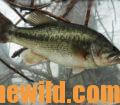Editor’s Note: Hunting season is not the time to be bass fishing, or at least that’s what most sportsmen once believed. However, in the last two decades, with the volume of information that has been unearthed about bass and bass angling, many fishermen have found that hunting season and the cold months of January and February are the most-productive times of the year to bass fish.
Plastic Worms:
For anglers who are reluctant to let a heavy bait with those hooks like a jigging spoon down in the trees, don’t forget about the plastic worm. Often when you pinpoint bass concentrated in deep 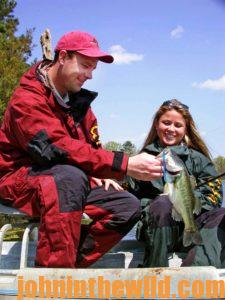 treetops and timber that won’t take a spoon, you can drop a Texas-rigged plastic worm on top of them to get the bass’s attention. Some deep, clear-lake anglers use a tactic called shaking. When the bass won’t hit the spoon, lower a 4-6 inch plastic worm down to the depth where the bass are holding. Then shake the lure. Don’t hop the bait – just quiver it until a bass takes it. Keep the bait at the same level, shake it, and use your trolling motor to move around through the school of bass. For some reason when bass won’t take a bait in the winter, they will bite this shaking worm.
treetops and timber that won’t take a spoon, you can drop a Texas-rigged plastic worm on top of them to get the bass’s attention. Some deep, clear-lake anglers use a tactic called shaking. When the bass won’t hit the spoon, lower a 4-6 inch plastic worm down to the depth where the bass are holding. Then shake the lure. Don’t hop the bait – just quiver it until a bass takes it. Keep the bait at the same level, shake it, and use your trolling motor to move around through the school of bass. For some reason when bass won’t take a bait in the winter, they will bite this shaking worm.
The Flutter Spoon:
Another kind of spoon that’s particularly effective in wintertime in highland lakes with clear water and little or no structure in them is a flutter-type spoon like the Dardevle
(https://dardevle.com/). The flutter spoon can be cast out or let down and then flutters all the way to the bottom. Unless an angler has a very-sensitive rod, knows the depth of the water and can feel his spoon as it falls, the flutter spoon can be a nightmare to fish. Ninety-nine percent of the time bass will hit th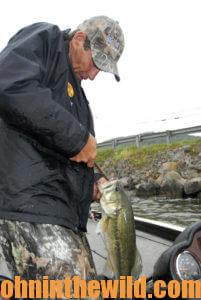 e flutter spoon on the fall when the line is slack. Therefore an angler must set the hook quickly and often will miss as many bass – if not more bass – than he catches.
e flutter spoon on the fall when the line is slack. Therefore an angler must set the hook quickly and often will miss as many bass – if not more bass – than he catches.
But I have fished the flutter spoon in some rivers with no structure when the bass were schooled- up on old drop-offs and had bass hit the spoon just about every time it went to the bottom. If I failed to get a bass just as the spoon fluttered down, once the bait was on the bottom, I ripped the lure up and expected a strike when the bait fell back. However, never fish the flutter spoon in treetops or heavy cover. That’s a quick way to lose your sanity, while trying to get the flutter spoon loose from the structure and breaking it off. But if you begin taking bass while utilizing the flutter spoon and know you’re in heavy cover, immediately change over to the heavy jigging spoon, so you won’t be as likely to stay hung all day.
Tackle to Use for Wintertime Bassing:
When vertical jigging in the wintertime, the angler needs an immediate, solid hookset. Mr. Bigmouth realizes quickly that the chunk of lead in his mouth is not a tasty baitfish. So, a bass will blow the jigging spoon out as fast as it sucks the lure in, if the hook isn’t set immediately at the time of the strike. Probably a cue stick with a winch on the end and a piece of cable is the optimum tackle to make the strongest hookset in the shortest time. However, since most anglers are 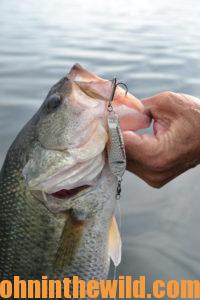 reluctant to use this type of apparatus, a stiff worm rod or flipping stick is more preferred.
reluctant to use this type of apparatus, a stiff worm rod or flipping stick is more preferred.
A baitcasting reel with a fast retrieve adds speed and power to the hookset, and 20-pound-test line with little or no stretch yields the best results. However, these general tackle rules are not applicable to all winter bass fishing/vertical jigging situations. If you’re fishing in a highland reservoir with clear water and little or no structure in it, you can use a lighter line. But if you’re angling a lowland lake with an abundance of timber in it, then 25-pound-test line may not be heavy enough.
Wintertime bassing can be some of the most-exciting fishing of the year. If you find the schools and start catching the bass, you often can catch 30 to 40 nice fish in a day. While everyone else is out chasing whitetails, trying to lure in waterfowl or searching for predators, you can have some of the best bass-fishing action of the year. 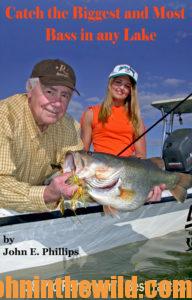
To learn more about bass fishing, check out John E. Phillip’s book, “Catch the Biggest and the Most Bass in Any Lake,” at http://amzn.to/Xd7qez, available in Kindle, print and Audible versions.

